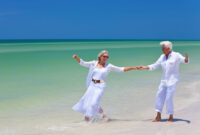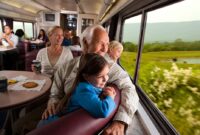Senior tour age is a fascinating topic, encompassing much more than just a numerical range. It’s about tailoring travel experiences to the unique needs and desires of older adults, considering physical capabilities, interests, and preferred travel styles. This exploration delves into defining “senior tour age,” exploring diverse tour types, addressing accessibility and safety, and examining effective marketing strategies for this valuable demographic. We’ll also consider the impact of technology and the cost-value proposition of senior-specific travel packages.
Understanding the nuances of senior travel allows tour operators to craft truly enriching and memorable journeys. From adventure-packed excursions to relaxing cruises, the possibilities are vast, and catering to the specific needs of different age brackets within the senior demographic is key to ensuring a positive experience for all. We’ll investigate the various factors influencing the choice of a tour, including physical capabilities, budget, and personal preferences, to create a comprehensive guide to planning the ideal senior travel experience.
Defining “Senior Tour Age”
The definition of “senior tour age” isn’t rigidly fixed; it’s a flexible range influenced by both societal perceptions and the specific policies of tour operators. While there’s no universally agreed-upon number, understanding the nuances of this age range is crucial for designing effective and inclusive travel experiences.
The age range typically considered “senior” for travel purposes generally falls between 55 and 65 years old, although many tour operators extend this to encompass individuals up to 75 or even 80. This broader range acknowledges the increasing health and vitality of many older adults. However, this isn’t a hard and fast rule.
Variations in Senior Tour Age Definitions
Cultural factors significantly impact how “senior” is perceived. In some cultures, individuals in their late 50s might be considered senior citizens, while in others, this designation might not apply until well into their 70s. Similarly, the definition often depends on the specific tour operator. Some companies might focus on active seniors, setting a higher age limit for adventurous excursions, while others might cater to a broader range of abilities and ages, offering gentler itineraries. For example, a tour specializing in trekking in the Himalayas would likely have a lower age limit than a cruise focusing on relaxation and sightseeing.
Physical Capabilities Across Senior Age Brackets
The physical capabilities of individuals within the senior demographic vary greatly. The 55-65 age bracket often displays high levels of energy and mobility, capable of participating in moderately strenuous activities. Those in the 65-75 range might require more rest and may have limitations in activities requiring extensive walking or standing. Individuals aged 75 and above may experience more significant physical limitations, necessitating slower paces, shorter distances, and potentially more assistance. This necessitates tour operators tailoring their itineraries and activities to accommodate the diverse needs of these subgroups. For instance, a tour for the 55-65 age group might include longer hiking trails, while a tour for the 75+ age group might focus on shorter walks and accessible transportation.
Types of Senior Tours
Senior tours cater to a diverse range of interests and physical capabilities, offering a wide array of experiences tailored to the needs and preferences of older travelers. Understanding the different types available helps individuals select a trip that aligns perfectly with their desired pace, activities, and overall travel style. This ensures a fulfilling and enjoyable travel experience.
Categorization of Senior Tour Types
Senior tours can be broadly categorized based on their primary focus and the type of activities they offer. These categories are not mutually exclusive; many tours blend elements from multiple categories.
Adventure Tours for Seniors
These tours typically involve moderate physical activity and exploration of natural landscapes. Itineraries often include guided hikes on relatively easy trails, scenic drives, wildlife viewing opportunities, and visits to national parks. Activities might involve gentle kayaking, birdwatching excursions, or even hot air balloon rides, all adapted to a senior’s physical capabilities. The emphasis is on experiencing the beauty of nature while maintaining a comfortable pace. For example, a tour might involve a leisurely hike through a redwood forest followed by a relaxing afternoon at a spa.
Relaxation and Wellness Tours for Seniors
These tours prioritize rest, rejuvenation, and stress reduction. The itinerary focuses on leisurely activities such as spa treatments, yoga sessions, meditation retreats, and quiet time for reflection. Destinations often feature tranquil settings, such as beach resorts, mountain spas, or cruise ships. Activities might include gentle water aerobics, tai chi classes, or simply relaxing by the pool. The pace is slow and unhurried, allowing ample time for relaxation and self-care. A typical day might include a morning yoga session, followed by a spa treatment, and an afternoon spent reading by the ocean.
Cultural and Historical Tours for Seniors
These tours immerse participants in the history, art, and culture of a specific region or country. Itineraries typically include visits to museums, historical sites, cultural performances, and local markets. Activities might involve guided tours of ancient ruins, cooking classes featuring local cuisine, or attending a traditional music concert. The pace is usually moderate, allowing ample time for exploration and appreciation of the cultural aspects of the destination. A tour might include a guided walking tour of a historic city, followed by a visit to a local museum and a traditional dinner.
Comparison of Senior Tour Types
| Tour Type | Target Age Range | Activities | Pace |
| Adventure | 60-80+ (with appropriate fitness level) | Hiking, scenic drives, wildlife viewing, kayaking (gentle), birdwatching | Moderate |
| Relaxation & Wellness | 55-85+ | Spa treatments, yoga, meditation, gentle water aerobics, tai chi | Slow |
| Cultural & Historical | 60-90+ | Museum visits, guided tours, cultural performances, cooking classes | Moderate |
Accessibility and Accommodation
Planning a senior tour requires careful consideration of accessibility to ensure a comfortable and enjoyable experience for all participants. Failing to account for the diverse needs of older travelers can significantly impact their ability to fully engage with the tour and its destinations. Prioritizing accessibility not only enhances the quality of the trip but also demonstrates a commitment to inclusivity and respect for all travelers.
Accessibility features are crucial for senior-focused travel because they address the physical limitations and changing needs that often accompany aging. These features enable older adults to participate fully in the tour, regardless of their physical abilities or mobility challenges. This translates to a more enriching and less stressful travel experience, fostering a sense of independence and confidence.
Accessible Bathroom Features
Accessible bathrooms are essential for comfortable and safe travel for senior citizens. These bathrooms should adhere to relevant accessibility standards, ensuring ease of use for individuals with mobility impairments. Key features include grab bars strategically placed near the toilet and shower, a roll-in shower with a low threshold for easy access, and a raised toilet seat for easier transfers. Adequate space for maneuvering a wheelchair or walker is also critical. The inclusion of a shower chair and a hand-held showerhead further enhances accessibility and safety. Appropriate lighting levels and non-slip flooring are also important safety considerations.
Accessible Transportation Options
Transportation is a significant aspect of senior travel, and accessible options are paramount. This includes providing transportation services with features like wheelchair lifts or ramps on buses and coaches. Furthermore, ensuring that destinations are easily accessible by wheelchair or other mobility aids is crucial. This may involve selecting hotels and attractions with appropriate accessibility features, and pre-arranging accessible transportation within the tour itinerary. Clearly communicated transportation schedules and procedures, allowing ample time for boarding and disembarking, also contribute to a smooth and stress-free experience.
Sample Accessible Hotel Room Layout
A sample accessible hotel room for senior tourists would feature a spacious layout, minimizing obstacles and maximizing maneuverability. The entryway would be wide enough to accommodate a wheelchair, with a threshold no higher than half an inch. The room would feature a king-size bed with adequate space around it for wheelchair access. A spacious accessible bathroom would include a roll-in shower with a built-in seat, grab bars around the toilet and shower, and a raised toilet seat. The sink would be mounted at a comfortable height, and ample counter space would be available. The room would be well-lit, with easy-to-reach light switches and electrical outlets. Emergency call buttons would be strategically placed throughout the room, including in the bathroom. Clear signage would be provided to easily identify all room features. The room would also include a visually accessible clock and thermostat. Furniture would be strategically placed to ensure ease of movement, and ample space would be provided between the furniture and walls.
Marketing and Targeting Senior Travelers
Reaching senior travelers requires a nuanced understanding of their needs and preferences. Effective marketing strategies must resonate with this demographic’s values, lifestyle, and concerns, focusing on building trust and conveying a sense of security and comfort. Ignoring these factors can lead to ineffective campaigns and missed opportunities.
Marketing to senior travelers differs significantly from marketing to younger demographics. They possess unique priorities, including value for money, ease of travel, and access to healthcare and support services. Understanding these priorities is crucial for developing successful marketing campaigns.
Effective Marketing Strategies for Senior Travelers
Senior travelers often value authenticity and personal recommendations. Word-of-mouth marketing, testimonials from past travelers, and partnerships with reputable organizations catering to seniors are highly effective. Visually appealing marketing materials featuring images of happy, active seniors enjoying their travels build trust and create a positive association with the brand. Clear and concise messaging that highlights ease of travel, accessibility features, and comprehensive support is essential. Guarantees and transparent pricing policies also contribute to building confidence. Finally, emphasizing the value proposition – what seniors gain from the tour – rather than focusing solely on price is crucial.
Comparing Marketing Channels for Senior Travelers
Print media, particularly magazines and newspapers targeting the senior demographic, remain a powerful channel. Many seniors still rely on print for information and prefer the tactile experience. However, online advertising is also increasingly important. Senior-focused websites, travel blogs, and social media platforms like Facebook offer targeted advertising options. Email marketing is another effective channel, allowing for personalized communication and targeted promotions. While younger demographics might be more receptive to social media influencers, for senior travelers, the endorsements of respected travel experts or organizations carry more weight. A multi-channel approach, combining print and digital strategies, generally yields the best results. For example, a print advertisement could include a QR code linking to a detailed online brochure or booking page.
Marketing Copy for a Senior Tour Package
Headline: Unforgettable European Adventure: Effortless Travel for the Discerning Traveler
Body Copy: Experience the charm of Europe without the stress. Our meticulously planned tour of [Country/Region] offers comfortable accommodations, seamless transportation, and expert guidance every step of the way. Enjoy guided tours of iconic landmarks, savor authentic local cuisine, and connect with fellow travelers who share your passion for exploration. Our inclusive package includes round-trip airfare, luxurious hotels with accessible amenities, and daily excursions designed with your comfort and well-being in mind. Travel with peace of mind knowing our dedicated support team is available 24/7. Limited spaces available – book your unforgettable journey today!
Cost and Value Considerations
The cost of a senior tour is influenced by a multitude of factors, ultimately determining the overall value proposition for the traveler. Understanding these factors allows for informed decision-making and a more satisfying travel experience. A transparent understanding of pricing is crucial for both the tour operator and the potential customer.
Pricing structures for senior tours vary considerably, impacting the perceived value. Several key elements contribute to the final cost, and discerning travelers should carefully consider these before booking.
Factors Influencing Senior Tour Costs
Several key factors significantly influence the overall cost of senior tours. These include the duration of the trip, the chosen destination and its associated travel costs (flights, ground transportation), the level of accommodation (from budget-friendly hotels to luxury resorts), the included activities and excursions, the level of guided services (private guides versus group tours), and the inclusion of meals. For example, a 10-day guided tour of Europe with luxury accommodations and multiple excursions will naturally cost significantly more than a 5-day bus tour of a nearby state with basic hotel accommodations and fewer included activities. The season of travel also plays a role; peak seasons typically command higher prices.
Value Proposition of Senior-Specific Travel Packages
Senior-specific travel packages offer a compelling value proposition by catering to the unique needs and preferences of older travelers. This often translates to a higher level of comfort, convenience, and accessibility. Features like slower paces, fewer strenuous activities, well-planned itineraries with ample rest time, and accommodations tailored for mobility challenges are common. The focus is on relaxation and enjoyment rather than rigorous sightseeing. The peace of mind provided by experienced tour guides and readily available support further enhances the value. For instance, a tour focusing on gentle walking tours of historical sites with frequent rest stops and comfortable transportation would be considered high-value for many senior travelers. The emphasis on relaxation and stress-free travel justifies the potentially higher cost per day.
Pricing Structures of Different Senior Tour Operators
Different senior tour operators employ varying pricing structures. Some may opt for all-inclusive packages, encompassing flights, accommodation, meals, excursions, and transportation. Others may adopt a modular approach, allowing customers to customize their tour by selecting specific components. For example, one operator might offer a single price covering everything, while another might charge separately for flights, accommodation, and excursions, allowing for greater flexibility but potentially higher overall cost if all options are selected. Carefully comparing the inclusions and exclusions is essential. It’s also important to note that the reputation and level of service provided by different operators will influence their pricing. A highly-rated operator with a strong track record of excellent customer service will often command a premium.
Final Summary
Planning a senior tour requires careful consideration of many factors, from physical capabilities and health concerns to accessibility and budget. By understanding the diverse needs and preferences of senior travelers, tour operators can create enriching and memorable experiences. This exploration has highlighted the importance of tailoring itineraries, accommodations, and marketing strategies to this specific demographic, ultimately ensuring safe, comfortable, and enjoyable travel for all. The focus should always be on creating a positive and enriching travel experience that caters to the individual needs and desires of each traveler, maximizing their enjoyment and creating lasting memories.




